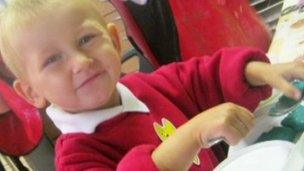Daniel Pelka murder: Teachers had concerns for starved boy
- Published

Staff at the school Daniel Pelka attended raised concerns about his weight
When four-year-old Daniel Pelka died he looked like a concentration camp victim and weighed less than two stone.
Teachers from his school, Little Heath Primary in Coventry, spoke of his stealing food from other children and scavenging in bins.
Teaching assistant Beatrice O'Brien told Birmingham Crown Court: "We watched him walk up to the bin, look to see if anyone was looking and pick out either the core of an apple or a pear and he started to eat it."
She said she found him "trying to get the last bit of yoghurt out" of an empty tube in another bin.
"I was very concerned. He did not look at all well and he had lost a lot of weight," she said.
The school raised concerns about his weight and the deputy head teacher rang Daniel's GP, who examined him and put him on a course of nutritional tablets.
An education welfare officer and the school nurse also visited his mother, Magdelena Luczak, 27.
She has been jailed, along with her partner Mariusz Krezolek, 34, after a jury at Birmingham Crown Court decided they first starved and then murdered Daniel.
But how much power do teachers have in getting concerns for a child's welfare followed up by the authorities?
'Growing disconnect'
David Tucker, head of policy at the NSPCC, said: "The worrying thing about this case is that there were teachers who were aware of the problems, they seemed to have taken some sort of action, but that course of action wasn't effective.
"There's a serious case review looking into that, so I wouldn't want to criticise anybody unfairly, but we need to understand what was happening between the school and children's social care."
The Coventry Safeguarding Children Board said it would publish a serious case review into Daniel's death in September.
The teaching union the NASUWT said it felt there was a "growing disconnect" between schools and social services because of government cuts.
General secretary Chris Keates said she believed the response schools got after making referrals often depended on the resources of the local authority, rather than how serious their concerns were.
"[Teachers] want timely action taken to investigate their concerns and reassurances that the child is safe while that is taking place," she said.
"There's a big gap that's been created by cuts and changes to government legislation, and that is not always happening."
One teacher from the West Midlands, who wanted to stay anonymous, said in her 10 years of experience, teachers had "minimal" influence on getting cases to social services level.
She said: "I had one child who, over a number of weeks, I noticed a few signs. He never said anything to me, but I noticed he was hungry coming into school, he was dirty. His clothes were never clean.
"I passed this on to our school safeguarding officer. It was then discussed at a CAF (Common Assessment Framework) meeting, but I had no further input after that.
"I know his mother was part of that meeting but don't know how far social services got involved."
She said she felt "left out of the loop" during the process but that early intervention did work in her instance.
The boy started attending the school breakfast club and his school work improved, she said.
Another teacher from North Staffordshire, who also did not want to be named, said teachers had to put "faith in the system and hope it worked".
He trained as a teacher in 2000 and was given mandatory online safeguarding training, which he said he felt was "adequate".
"You do feel powerless in the sense that what you want to do at the end of the day is to jump in your car and drive round to that family's house and shake them," he said.
"You just have to hope the school's child protection strategy kicks into place after your initial concern, and that the problem is dealt with by the right people."
'Extremely exposed'
The government announced new child protection guidelines for teachers in March, which it has just finished a consultation on.
It plans to reduce its original 120-page Safeguarding Children and Safer Recruitment in Education, external document, originally published in 2007, to about 30 pages.
The NASUWT said this reduction in guidelines would leave schools and teachers "extremely exposed".
Ms Keates said: "Since 2010, when the government reduced red tape in the child protection system, a number of things have hit the floor that were there to protect not only children but teachers as well.
"Detailed guidance is being replaced with lines like 'You should make sure people are appropriately trained' without giving any detail about what that training should be.
"If something goes wrong the government can say 'We told you people should be appropriately trained' but they've taken away all the detail of what 'appropriate' is."
A spokesman for the Department of Education said teachers needed "to use their professional judgment to make commonsense decisions to protect children".
He said: "We have consulted on revised guidance which will allow schools and further education colleges to exercise their own judgement on how to respond to safeguarding issues based on their assessment of individual situations.
"We are analysing the responses and will publish the guidance in due course."
- Published11 March 2013
- Published23 January 2012
- Published12 June 2012